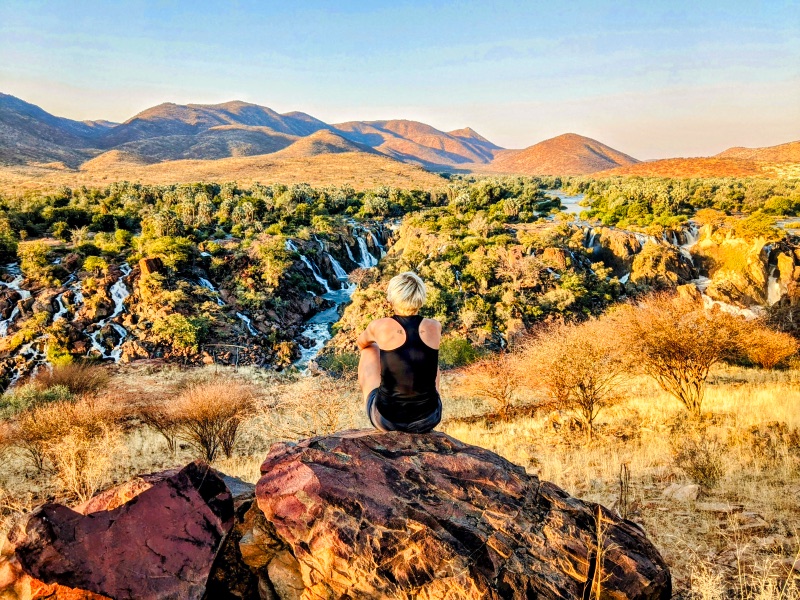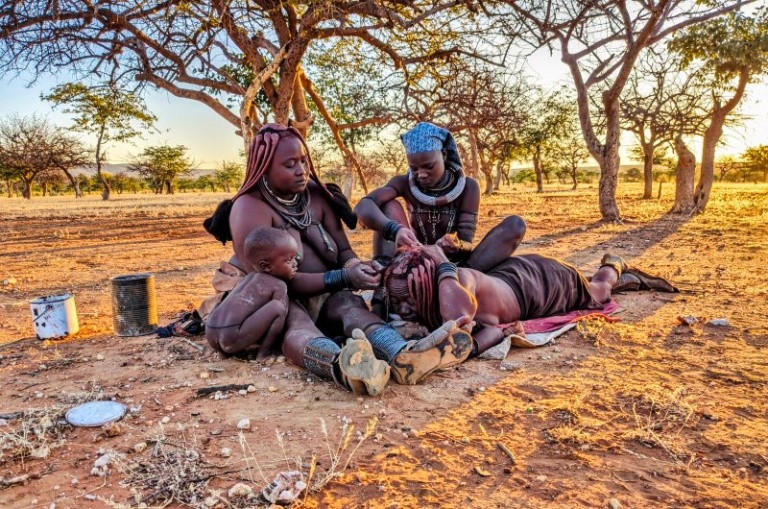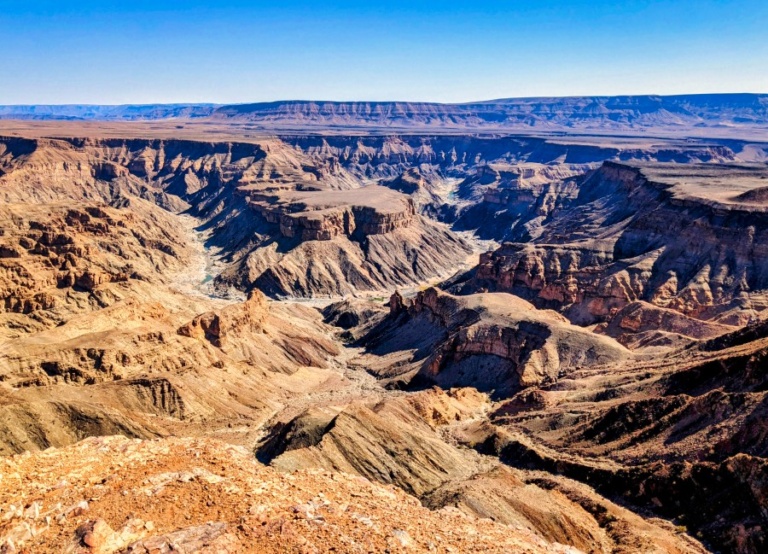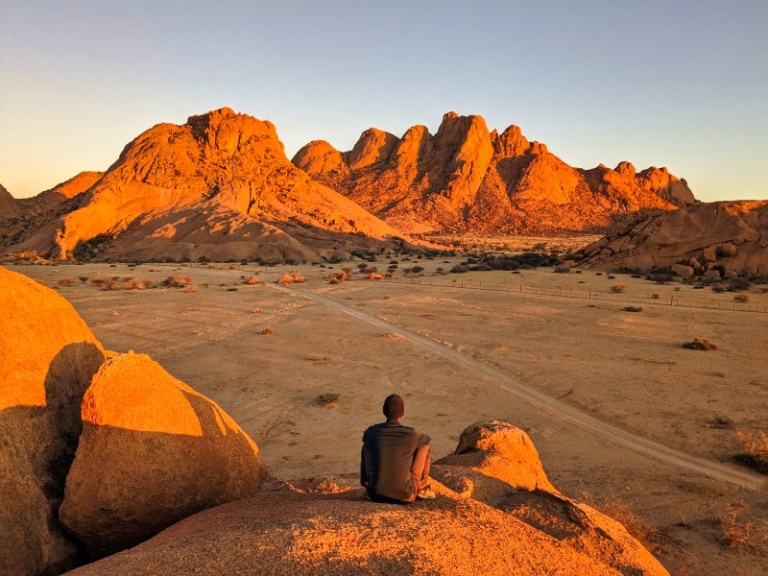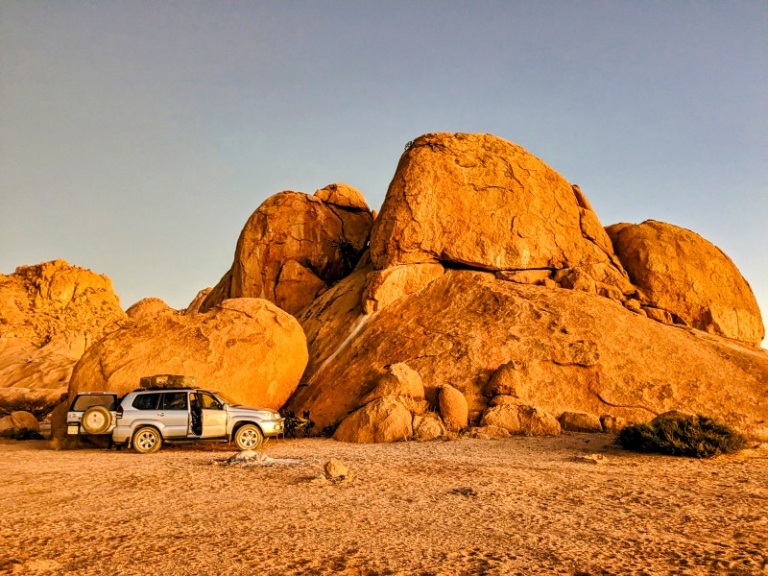The Ultimate Guide to Kaokoland, Including Epupa Falls
Kaokoland (otherwise known as the Kunene Region), in Namibia’s far north, is the ultimate off-the-beaten-track destination. If you love to explore remote, wild places, far away from the tour buses of the centre, then this is it. Epupa Falls is the star of the region, but Kaokoland offers so much to explore.
Think wide open spaces, unlimited seclusion and unbeatable desert scenery. A magical waterfall set in an otherwise arid zone. Kaokoland is Namibia at its wildest and most adventurous.
Sound like your cup of tea? Read on for our complete guide to Kaokoland and Epupa Falls.
Namibia Travel Resources
- Getting there: search for flights to Namibia
- Where to stay: find a guesthouse, hostel or hotel
- Guidebook: pick up a copy of Bradt’s Namibia
- How to get around: rent a car or 4WD
- Travel insurance: get travel insurance for your trip
- Money: get a Wise travel card to save big time in Namibia
- Gear: pick up a Steripen for clean water 24/7
Kaokoland: Overview
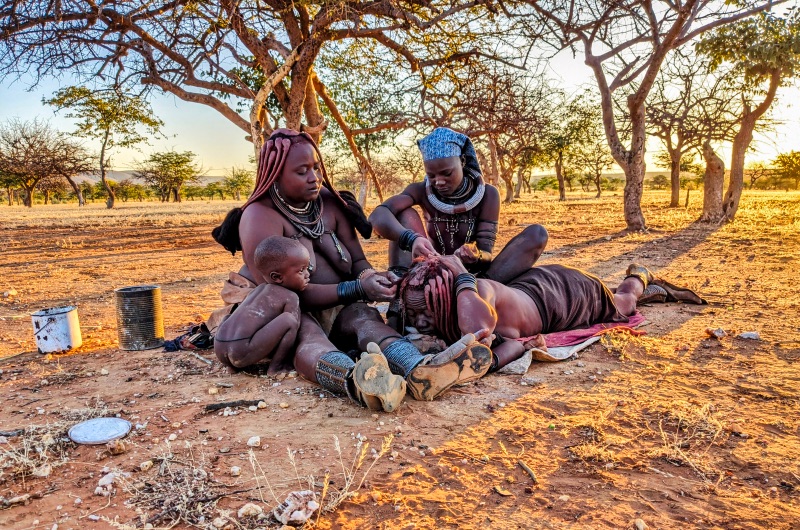
Kaokoland is the informal name for the Kunene Region, the far northwest region of Namibia. It’s a vast tract of land that is both enticing and inhospitable.
Kaokoland covers the area from the Hoanib River in the west to the Kunene River in the north, which also acts as the border with Angola.
The area is largely dry, rocky and mountainous. Except for the relatively lush area around Epupa Falls, expect dry, desert conditions. There are very few formal settlements and plenty of open and expansive spaces.
Kaokoland is home to both the Herero and the Himba people, although by and large most visitors associate it mainly with the photogenic Himba.
Long cut off, the main arteries in Kaokoland have vastly improved in recent years, making it much more accessible to the independent traveller.
Don’t mistake this accessibility for ease though – this is still the most remote part of Namibia and all travellers to the region need to be well-prepared. Towns are rare, services are few and distances are long, so before heading off, ensure you’re ready to tackle the adventure that is Kaokoland (read more below).
Related: 10 Epic Namibia Camping Sites + Essential Tips
When to Visit Kaokoland
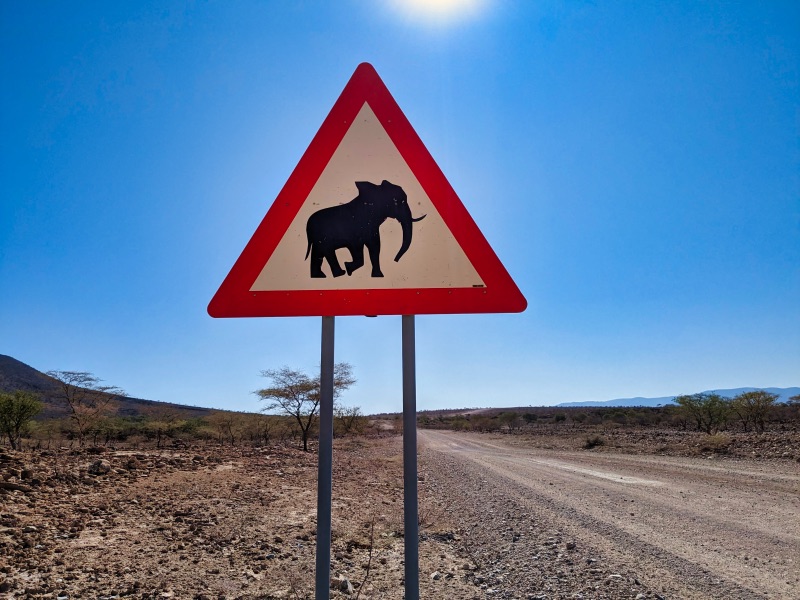
The best time to visit Kaokoland is between May and September. This is during Namibia’s winter and dry season, so is when the weather is at its mildest and driest.
During these months, you can expect warm days and pleasant evenings. Unlike most other parts of Namibia, the nights aren’t very cold and you won’t need those down jackets. The evenings are relatively mild and a simple long sleeve shirt should suffice to keep you warm.
Visiting Kaokoland during the rainy season is extremely challenging and not advised to do independently. There are frequently deep rivers in flood and a lot of mud which even the strongest 4×4 can easily get stuck in. If this is something you are interested in, we suggest you look up an organised tour with a specialist operator. Khowarib Lodge is a good place to start making inquiries.
Read next: The Essential Guide to Hiking Fish River Canyon
How to Travel Around Kaokoland
As with all places in Namibia, to travel around Kaokoland, you need your own car. To fully take advantage of the area, you also need your own camping gear.
Fortunately, it’s very easy in Namibia to rent a 4WD with a complete camping kit, and this is indeed what 99% of visitors to the country do.
Pro tip: use Discover Cars to find the best deals on rentals. It’s what we personally use and recommend.
In addition to the basic camping supplies, you’ll want 2 spare tires, a vehicle recovery kit, a shovel, an air compressor, a minimum of 50L of water, and ideally a satellite phone or beacon in case shit hits the fan.
You’ll also want to stock well up on food, because once you pass Opuwo, your options to buy more pretty much diminish.
If you’re heading to the more remote parts of the region (i.e., Purros and the Western Valleys), you’ll ideally want a convoy of at least 2 cars. That said, people do go on their own, but need to be very well-prepared and experienced.
Important: This part of Namibia is remote and accidents happen. Make sure you’re covered by adequate travel insurance. We use and recommend SafetyWing. Trust us, we’ve used a ton of travel insurance, and they really are the best.
Where to Get Supplies in Kaokoland
Opuwo is pretty much the only place to stock up on supplies in Kaokoland. Be sure to stock up well, because once you leave Opuwo, you won’t find a hell of a lot else.
Fortunately, you can find most services you need in Opuwo. There are two supermarkets: an OK Food and a Spar – OK Food has a better selection than Spar. There are a number of pharmacies in town if you need any medication.
There are plenty of fuel stations and, helpfully, a solid mechanic if you need to get work done or buy a new tire (trust us, you might). If you find yourself in need of tires or a repair, head to Kunene Outfitters, which is in the orange and black building near the OK Food.
There are a number of roadside tire repair places in Kaokoland, but they don’t always do the best job. If you need some work on our tires, you’re best off doing so in Opuwo.
Exploring more of southern Africa? Check out our guide on the best alternative things to do in Zambia
Where to Go and What to Do in Kaokoland
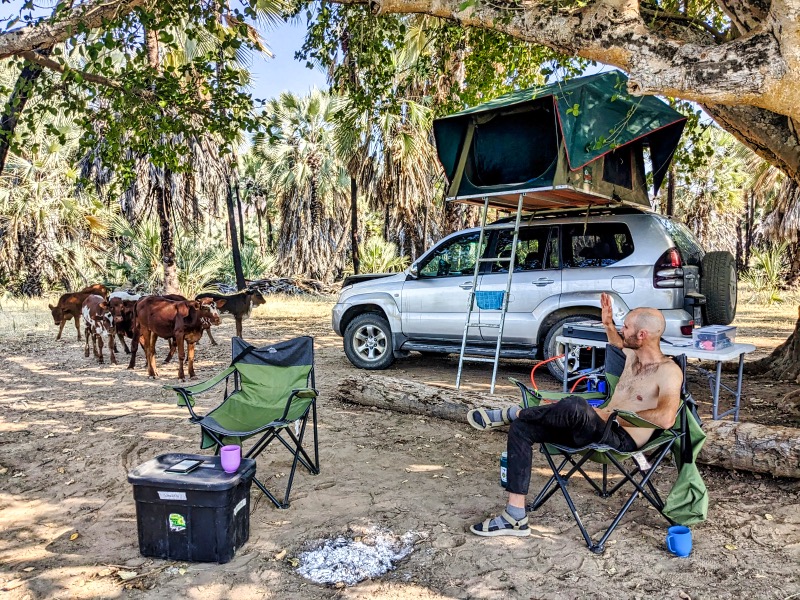
There are so many amazing places to visit in Kaokoland. If you’re adventurous and like wild exploration, this is just the place for you. While Epupa Falls is the clear star, we highly recommend checking out some of the other, smaller attractions.
Read our Complete Guide to Visiting Spitzkoppe
Khowarib
Khowarib is a little community smack bang on the C43 en route to Opuwo. It’s not well known, but that’s precisely what makes it so special. It’s a hidden gem and a wonderful place to stop to break up the long journey in Kaokoland, especially if you’re on your way to Opuwo from destinations further south.
What makes it so special? Well, Khowarib is set at precisely the position where the desert begins to meet the tropics. There’s still a desert vibe, but vegetation becomes more lush and – gasp! – there’s even water in the river! It reminds us of the area around the Jatbula Trail in Australia.
With not a lot of visitors, Khowarib is also incredibly tranquil. There’s not a ton to do here, but if it’s relaxing you’re after, look no further.
Where to Stay in Khowarib
There are two places to stay in Khowarib, both of which are fine choices.
Khowarib Community Campsite

The Khowarib Community Campsite is a great, albeit basic spot, and is one of our favourite campsites in Namibia. It’s a great example of a community-run campsite: it’s well maintained, the sites are large and some even have their own private verandah overlooking the beautiful valley.
There are private ablutions with hot-water showers.
If you’re after more amenities or luxury, then check out the Khowarib Lodge. It’s a bit more upscale and has more facilities, like a pool and a bar.
They can also organise tours and we can personally vouch that their owner, Caesar, is very friendly. (He lent us a spare tire when we blew two in one day).
What to Do in Khowarib
Chilling out is the name of the game here, but you can also walk around the river valley a bit. It’s not that exciting, but it’s nice to stretch the legs after long days driving in Namibia.
If you’d like some organised activities, check in at the Khowarib Lodge, as they run a full program of tours.
Purros
Purros is a remote village set on the (dry) Hoarusib River on the D3707, 100 km from Sesfontein. It’s around 3-4 hours from Sesfontein on a notoriously bad road: you’ve been warned. It’s gotten better in recent years, but it’s still one that requires experience and preparation.
Purros is largely a Himba area, becoming increasingly more popular with visitors (although still very off the beaten track). Its prize is its fantastic location: where the mountain landscape transforms into the desert.
It’s also well-known for its desert-adapted elephants, which are commonly found in the riverbed behind the village and which make regular visits to the various campsites.
Where to Stay in Purros
Purros Community Campsite
Okongo Camping
What to Do in Purros
Most people come to Purros to experience the incredible landscape and the chance to spot the unique desert-adapted wildlife. Indeed, spending a few days soaking it all up is a fine choice.
There are also scenic drives and a viewpoint towards the Skeleton Coast.
As Purros is largely a Himba area, you can visit a Himba village. If doing so, you’ll get more out of it if you get a local to guide you around. As always, be sure to follow responsible tourism practices for visiting the Himba.
Opuwo
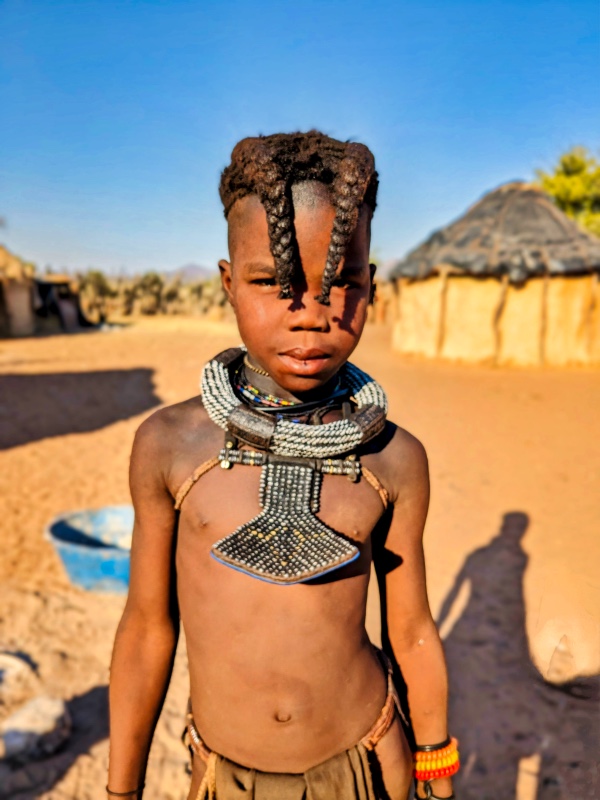
No visit to Kaokoland is complete without a visit to Opuwo, the rough and ready frontier town at the beating heart of Kaokoland. Opuwo is wild and dusty, but also amazing.
There’s not much to do in Opuwo itself, but the best part of Opuwo is just people-watching and soaking in the vibe. You’ll see so many different people going about their day – the fantastically ochre-painted Himba women, the Victorian-dressed Hereros and then just the Afrikaan farmers. There really are not many places on Earth that feel like this.
Important: Please don’t give kids stuff in Opuwo, or on the highway for that matter. Not only does it promote begging, but many of these children don’t have access to dental care, so sweets are especially detrimental. Many guides we met really lamented this behaviour and were upset about tourists giving kids stuff as it’s made the behaviour worse in recent years.
Where to Stay in Opuwo
Easily the best in town, whether you’re camping or lodging. The sites are large and well-equipped and the pool is very refreshing in the hot Kaokoland climate.
Another fine choice, with options for both camping and lodging.
A great option if you’re looking for a room.
What to Do in Opuwo
As the Himba capital, Opuwo is the best place to organise a visit to a Himba tribe.
Read our full guide on How to Visit a Himba Tribe Ethically and Responsibly
Epupa Falls
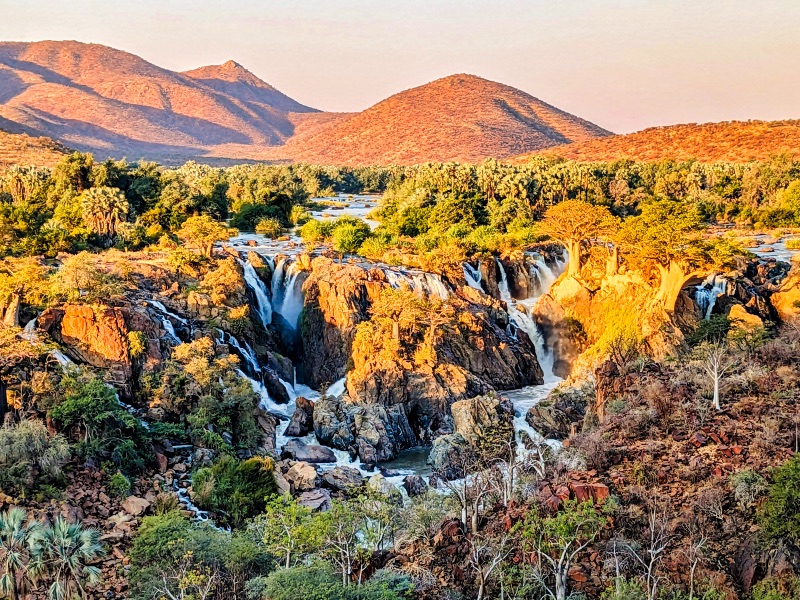
Epupa Falls is the biggest attraction in Kaokoland and for good reason – it’s a magical spot! We absolutely loved it and no photo can capture the essence of the area.
As Zandy has described it, it’s like an oasis on steroids.
Epupa Falls is where the Kunene River plunges into a geological fault, creating a series of cascades. And we mean series! From the viewpoint, you’ll see multiple cascades crashing down 30 – 60 metres.
Epupa Falls is approximately 180 north of Opuwo on the C43. The road north has been graded and isn’t nearly as bad as it used to be. You’ll still want to take your time though, so factor in at least 3.5 hours.
To get the most out of the area, stay at least one night at Epupa Falls. The sunset at the falls is incredible and should not be missed. Don’t be surprised if you find yourself staying longer!
Where to Stay at Epupa Falls
Eupa Falls Viewpoint Camp
This is a locally-run, community camp at the viewpoint to Epupa Falls. It costs 120 pppn, but there is space for negotiation.
There are no facilities up there (and no water) and it can get hot, but the views are great, making it a great budget choice.
Epupa Falls Lodge and Campsite
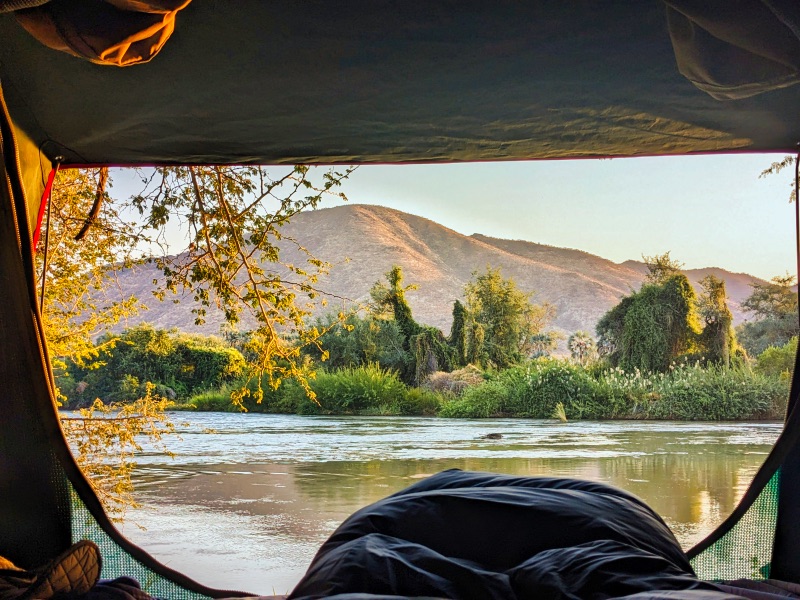
Epupa Falls Lodge and Campsite is where we stayed and is our first choice.
The campsite is directly at the falls and on a nice grassy are. It’s 200 pppn and there are great facilities (even a swimming pool!).
This is a more expensive option (210 pppn) and it’s quite away from Epupa Falls, so you don’t get the same ‘falls’ experience. The campsite is also a bit of a walk from the rest of the lodge.
What to Do at Epupa Falls
Depending on your desires and budget, you can do as much or as little as you want at Epupa Falls!
All of the lodges have organised activities – be it rafting, bird-watching or guided walks. We didn’t undertake any of these, but people seem to be generally happy with them.
Walking to Epupa Falls along the basic trail is a must-do, especially for sunset. To find the trail, just head past the Epupa Falls Community Campsite and you can’t miss it.
Watching the colours of the landscape around Epupa Falls change as the sun goes down is so magical. There are a number of beautiful spots. We were highly impressed with one couple who brought up camping chairs and cold drinks!
You can easily visit a Himba village from Epupa Falls.
Important: do not swim in the Kunene River. It’s home to a lot of crocs and maybe even a hippo or two.
Drive Along the Kunene River
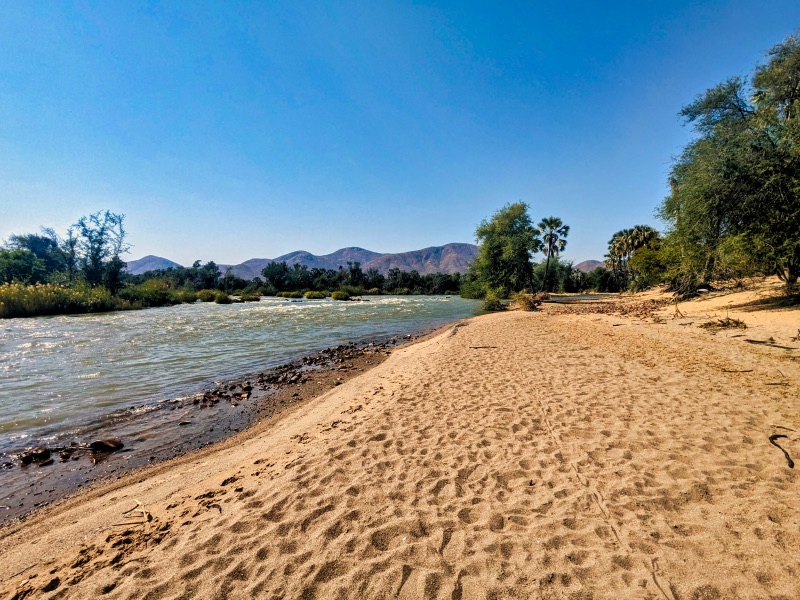
Taking a drive along the D3700 from Epupa Falls to Ruacana along the Kunene River is fabulous. The D3700 has been recently graded, so it’s no longer the frightening, expedition-only 4WD road that it used to be.
It’s mostly in decent shape, with a few rough patches that require high clearance. You still need a 4WD and prepared. If you drive it straight, you can probably get it done in around 5 hours, but we recommend spending one night en route. There’s some magnificent wild camping along this stretch.
The road features great views, both of the Kunene River and the hills in neighbouring Angola. Above all, it’s quiet and peaceful, so it’s a fantastic journey to make if you’re seeking some seclusion and isolation.
If doing this trip, be sure to pack adequate food, water and spares. There is some traffic along this route, but not a lot. We spent 3 days driving this and on the first day, didn’t have a single car pass us.
If you don’t want to wild camp, there are some established options along the way:
Set beautifully on the river with fantastic amenities, Camp Cornie cost 200 NAD pppn.
Enyandi Community Campsite
This is a beautiful spot run by the local community. There are no facilities at all (except for some provided firewood), so it is essentially wild camping.
It’s a great budget option (at 70 pppn) and a fantastic way to support the local community, but do note that during our stay we had A LOT of local visitors, so you may not get the privacy you’re after.
Kunene Islands Campsite
We haven’t stayed here, but reports are positive. It costs 150 pppn with basic ablutions but otherwise decent facilities (electricity and water at sites).
Disclaimer: This post contains affiliate links. This means that if you buy or book anything through them, we’ll earn a small commission at no extra cost to you. This helps us run this website and create comprehensive guides to help you get off the beaten track. We only recommend products and/or services that we use ourselves and trust.

